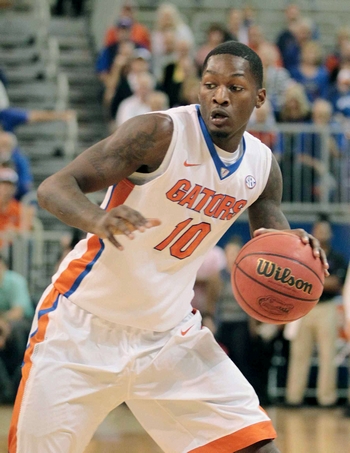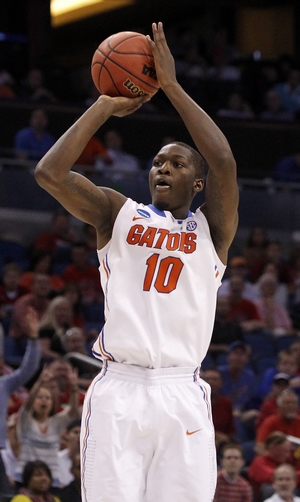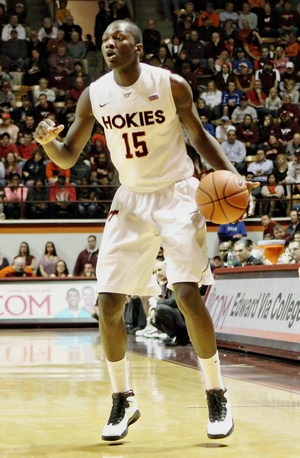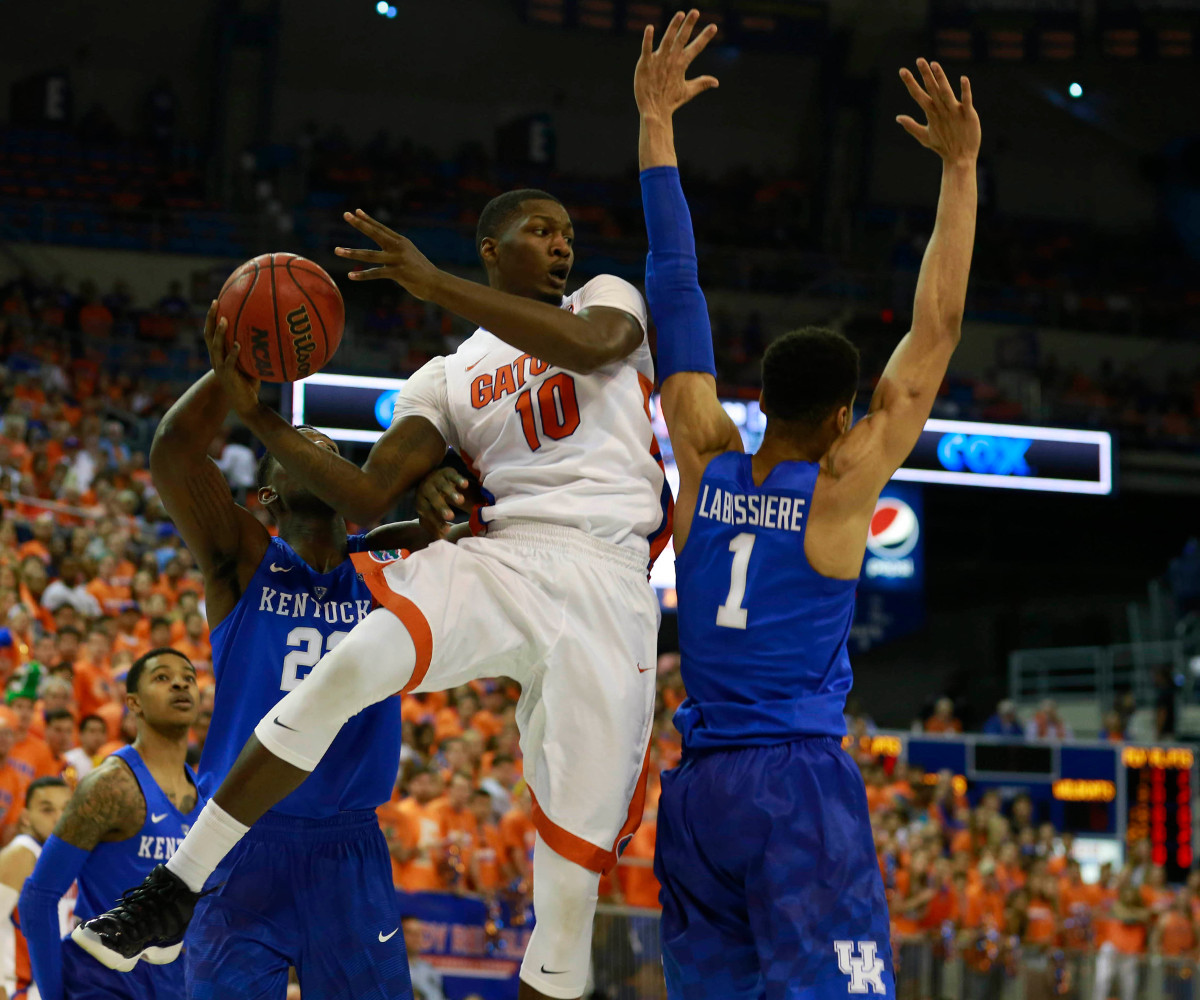Articles
2016 Portsmouth Invitational Tournament Measurements and Analysis
Apr 18, 2016, 03:14 pm
-Florida standout Dorian Finney-Smith confirmed the many measurements we have on him dating back to 2010, measuring 6'7.5 in shoes with a 215-pound frame. While not exceptionally tall or bulky for a combo forward, he compensates with a strong near-7-foot wingspan. The Portsmouth native had an outstanding week playing in front of family and friends, showing he's a cut above anyone in attendance, and likely helping his NBA stock significantly in the process.
NBA Draft Prospect of the Week: Dorian Finney-Smith
Feb 06, 2016, 01:00 am
Scouting Report by Matt Williams, Video Analysis by Mike Schmitz
A player we've written about in some depth every season since his impressive freshman campaign at Virginia Tech, Florida senior Dorian Finney-Smith has continued his climb towards All-SEC 1st Team honors in his first season under Head Coach Michael White, solidifying himself as one of the top NBA forward prospects in this year's senior class. Averaging 15.1 points, 8.3 rebounds, and 2.3 assists per game, the Virginia native doesn't play a huge role offensively, but has been a consistent performer for the better part of two seasons, one of the reasons we're electing to evaluate him now.
Standing 6'8 with a 6'11 wingspan, Finney-Smith's size for the small forward position has long been one of his most appealing assets as a prospect. A consensus top-25 player in the high school class of 2011 coming out of I.C. Norcom High School in Portsmouth, Virginia, Finney-Smith is also a fluid athlete possessing good speed and leaping ability to go along with a 220-pound frame that's developed significantly over his 5 year college career. Though he remains on the lanky side and isn't overwhelming quick laterally, Finney-Smith possesses very solid physical tools for a small forward at the NBA level and even the potential to play the four in smaller lineups just as he does for the Gators.
On top of his ideal size, Finney-Smith has developed a skill set that lends itself well to filling a niche as a roleplayer at the next level and allows him to make a consistent contributions as the first-option on Florida team that doesn't have a polarizing focal point offensively. Finney-Smith's foremost offensive skill is his perimeter jump shot.
An erratic shooter early in his career, the turning point for Finney-Smith came after a very poor shooting performance late in his sophomore season when he was coming off the bench for the Gator squad that fell to eventual National Champion Connecticut in 2014. Shooting 3-21 from beyond the arc over his last 7 games that season, Finney-Smith clearly made an effort to improve his range. He has shot 42% from beyond the arc over his final two seasons in Gainesville.
With 45% of his field goal attempts in the half court coming on catch and shoot jump shots according to Synergy Sports Technology, Finney-Smith does most of his scoring with his set shot. Though his mechanics are a bit unorthodox as he gets little elevation and takes the ball further behind his head than most turning his release into a bit of a fling, it is difficult to argue with the results over the last two seasons even if his misses are ugly at times. The senior wasn't always a great shooter, and his 72% shooting from the foul line doesn't jump off the page, but his ability to stretch the floor is perhaps his most intriguing offensive skill from an NBA perspective.
More than just a set shooter, Finney-Smith also flashes the ability to attack closeouts and finish strong inside. Though he isn't very shifty with the ball in his hands and tends to be very right hand dominant dribbling the ball fairly high, he is comfortable using rangy strides to drive past slower or overaggressive defenders from the wing in the half court. Shooting 57% as a finisher, he isn't overwhelmingly proficient inside as he lacks blow-by quickness and struggles to score over length, but he can play above the rim and will and use both hands to convert reverse layups inside.
Though Finney-Smith is not a prolific shot creator and or comfortable pulling-up from the midrange off the bounce at this point, he does generate a bit of offense for himself, primarily with face-up jump shots on mid-post isolations, using his size and jump shot to his advantage. He is also adept at moving without the ball, whether he is getting up the floor and spotting up, taking the ball to the rim using simple crossovers and step-throughs in transition, or cutting to the rim when his defender goes to help in the half court, he does a nice job staying active. An unselfish passer who can make the simple play, Finney-Smith does a bit of everything offensively which should help him blend in nicely at the next level.
Aside from his ability to score, Finney-Smith makes his biggest impact crashing the boards. Averaging 10.6 rebounds per-40 minutes pace adjusted to rank 5th among the prospects in our top-100 that stand under 6'9, the fifth year senior does an very good job pursuing the ball off the rim on both ends for a small forward, using his length and timing to his advantage.
Defensively, Finney-Smith has nice tools for the next level, but is a bit of a mixed bag at this point. He flashes the ability to defend four positions effectively as the Gators switch liberally in the half court as their athleticism one-through-fives make them one of the nation's top defenses. Despite that, the senior struggles defending quicker players on the perimeter at times giving up more dribble penetration than one would hope and isn't entirely comfortable on the block against bigger, polished post scorers either. To his credit, he doesn't quit on plays when he's beat and comes up with his share of blocks and steals by virtue of his length.
Turning 23 in May, Finney-Smith may not have outstanding upside, but his size, versatility, and roleplayer potential will earn him plenty of workouts as he could be a candidate to fill the trendy 3 and D role if he can put everything together. An obvious invitee to participate in the Portsmouth Invitational Tournament in front of a hometown crowd, Finney-Smith could certainly be one of the players in their year's senior class to hear his name called on draft night.
A player we've written about in some depth every season since his impressive freshman campaign at Virginia Tech, Florida senior Dorian Finney-Smith has continued his climb towards All-SEC 1st Team honors in his first season under Head Coach Michael White, solidifying himself as one of the top NBA forward prospects in this year's senior class. Averaging 15.1 points, 8.3 rebounds, and 2.3 assists per game, the Virginia native doesn't play a huge role offensively, but has been a consistent performer for the better part of two seasons, one of the reasons we're electing to evaluate him now.
Standing 6'8 with a 6'11 wingspan, Finney-Smith's size for the small forward position has long been one of his most appealing assets as a prospect. A consensus top-25 player in the high school class of 2011 coming out of I.C. Norcom High School in Portsmouth, Virginia, Finney-Smith is also a fluid athlete possessing good speed and leaping ability to go along with a 220-pound frame that's developed significantly over his 5 year college career. Though he remains on the lanky side and isn't overwhelming quick laterally, Finney-Smith possesses very solid physical tools for a small forward at the NBA level and even the potential to play the four in smaller lineups just as he does for the Gators.
On top of his ideal size, Finney-Smith has developed a skill set that lends itself well to filling a niche as a roleplayer at the next level and allows him to make a consistent contributions as the first-option on Florida team that doesn't have a polarizing focal point offensively. Finney-Smith's foremost offensive skill is his perimeter jump shot.
An erratic shooter early in his career, the turning point for Finney-Smith came after a very poor shooting performance late in his sophomore season when he was coming off the bench for the Gator squad that fell to eventual National Champion Connecticut in 2014. Shooting 3-21 from beyond the arc over his last 7 games that season, Finney-Smith clearly made an effort to improve his range. He has shot 42% from beyond the arc over his final two seasons in Gainesville.
With 45% of his field goal attempts in the half court coming on catch and shoot jump shots according to Synergy Sports Technology, Finney-Smith does most of his scoring with his set shot. Though his mechanics are a bit unorthodox as he gets little elevation and takes the ball further behind his head than most turning his release into a bit of a fling, it is difficult to argue with the results over the last two seasons even if his misses are ugly at times. The senior wasn't always a great shooter, and his 72% shooting from the foul line doesn't jump off the page, but his ability to stretch the floor is perhaps his most intriguing offensive skill from an NBA perspective.
More than just a set shooter, Finney-Smith also flashes the ability to attack closeouts and finish strong inside. Though he isn't very shifty with the ball in his hands and tends to be very right hand dominant dribbling the ball fairly high, he is comfortable using rangy strides to drive past slower or overaggressive defenders from the wing in the half court. Shooting 57% as a finisher, he isn't overwhelmingly proficient inside as he lacks blow-by quickness and struggles to score over length, but he can play above the rim and will and use both hands to convert reverse layups inside.
Though Finney-Smith is not a prolific shot creator and or comfortable pulling-up from the midrange off the bounce at this point, he does generate a bit of offense for himself, primarily with face-up jump shots on mid-post isolations, using his size and jump shot to his advantage. He is also adept at moving without the ball, whether he is getting up the floor and spotting up, taking the ball to the rim using simple crossovers and step-throughs in transition, or cutting to the rim when his defender goes to help in the half court, he does a nice job staying active. An unselfish passer who can make the simple play, Finney-Smith does a bit of everything offensively which should help him blend in nicely at the next level.
Aside from his ability to score, Finney-Smith makes his biggest impact crashing the boards. Averaging 10.6 rebounds per-40 minutes pace adjusted to rank 5th among the prospects in our top-100 that stand under 6'9, the fifth year senior does an very good job pursuing the ball off the rim on both ends for a small forward, using his length and timing to his advantage.
Defensively, Finney-Smith has nice tools for the next level, but is a bit of a mixed bag at this point. He flashes the ability to defend four positions effectively as the Gators switch liberally in the half court as their athleticism one-through-fives make them one of the nation's top defenses. Despite that, the senior struggles defending quicker players on the perimeter at times giving up more dribble penetration than one would hope and isn't entirely comfortable on the block against bigger, polished post scorers either. To his credit, he doesn't quit on plays when he's beat and comes up with his share of blocks and steals by virtue of his length.
Turning 23 in May, Finney-Smith may not have outstanding upside, but his size, versatility, and roleplayer potential will earn him plenty of workouts as he could be a candidate to fill the trendy 3 and D role if he can put everything together. An obvious invitee to participate in the Portsmouth Invitational Tournament in front of a hometown crowd, Finney-Smith could certainly be one of the players in their year's senior class to hear his name called on draft night.
Top NBA Prospects in the SEC, Part 9: Prospects #9-14
Oct 02, 2015, 12:08 pm
Jonathan Givony
The SEC's sixth man of the year as a sophomore, Dorian Finney-Smith became a full-time starter as a junior, and delivered a strong season individually, culminating in Second-Team All-SEC honors. It was ultimately a disappointing year overall however, as the team stumbled to a sub-500 record, their worst campaign in nearly 20 years, missing postseason play for the first time since Billy Donovan's debut season at Florida. With Donovan moving on to coach the Oklahoma City Thunder, the Gators and newcomer Michael White will be looking to fifth-year senior Finney-Smith for leadership in what appears to have the makings of a transition year for the program.

Listed at 6-8 by Florida, and measuring consistently between 6-7 and 6-8 in shoes the last few years, with a 6-11 wingspan, Finney-Smith has very good size for the small forward position and probably adequate height to play some small-ball power forward like he's mostly done in college thus far. He's added 25 pounds since the first measurement we have in our database back in 2010, and now sports an impressive frame that looks ready for the rigors of playing professional basketball at the highest levels.
Although he led the Gators in scoring last season, Finney-Smith is undoubtedly a role-player even at the college level, seeing almost all of his offense playing off the ball, whether its spotting up from the 3-point line, crashing the offensive glass, running the floor, or cutting/rolling to the basket.
He made some dramatic improvements between his sophomore and junior seasons in a few different areas, though, upping his 2P% from 44 to 50%, and his 3P% from 29 to 43%, which increases his appeal as a pro prospect significantly considering the type of role he'll most likely be asked to play.
Finney-Smith's improvement from the perimeter is perhaps the most notable as far as his NBA stock is concerned. While he still shoots a two-handed jumper while releasing the ball from the side of his head, he seems to have found a more repeatable and smooth stroke now, complete with a consistent release point, which he looks far more confident with. He saw excellent results with it as a junior, making 46% of his catch and shoot jumpers, the second best rate among returning draft prospects. Long-armed 6-8 combo forwards who can stretch the floor and defend their position are increasingly valuable in today's NBA, making Finney-Smith's improvement from the perimeter very intriguing.
Beyond that, Finney-Smith finds subtle ways to contribute offensively, crashing the glass, sprinting in transition, or moving intelligently off the ball and into open spaces. He is very effective around the basket when he's not the one creating his own offense, as he finished a solid 55% of his looks inside the paint in the half-court. He also kept mistakes to a minimum, turning the ball over on just 14% of his used possessions, while doing a nice job of making the extra pass unselfishly and fueling his team's ball-movement. All these things bode well for his potential of carving out a role at the NBA level, where he'll never be the most talented player on the floor.
With that said, while Finney-Smith's junior season provided us with a decent sample size of 3-pointers, with 115 attempts, his 59% free throw percentage (career 61%) still makes you wonder if his dramatic shooting improvement as a junior is indeed here to stay. NBA teams will want to see him carry over his success to his final season of college basketball, helping to up his career 35.7% 3-point percentage closer towards the 40% area possibly.
That will be very important, since it seems unlikely that Finney-Smith will ever emerge as a high-level shot-creator at this point. He remains a crude ball-handler in the half-court, struggling to do much damage even in transition or attacking closeouts in a straight-line. Finney-Smith can use his solid first step and chiseled frame to get to the rim if a lane is there, but he has no real left hand, and is incapable of changing speeds or directions if the defense rotates in his direction.
Due to his powerful frame, he seems to look a little more explosive than he actually is, as he really struggles to finish around the rim in traffic, partially due to the fact that he does not have great touch (which may help explain his struggles as a free throw shooter). When he does get all the way to the basket, he rarely appears to be fully on-balance, making it difficult for him to get off an under control layup attempt. Needless to say, he doesn't draw many fouls inside the paint, only getting to the free throw line 4 times per-40 minutes last season.
Defensively is where NBA teams might be the most intrigued by Finney-Smith's long-term potential. At 6-8, with a chiseled frame, he's big and strong enough to contain most power forwards he'll encounter, but also has the length, quickness and agility needed to step outside and guard perimeter players as well. His multi-positional versatility defensively is reflected in the 1.7 steals and 1.3 blocks he averages, making him one of only a dozen or so returning draft prospects to post that combination. On top of that, he's hauled in a career 10.2 rebounds per-40 minutes on average, which is a very nice added bonus.
Turning 23 in May, Finney-Smith will be among the older players in next year's draft, which makes this an important season for him from a production standpoint. With that said, his ready-made role-playing status eases those concerns a bit, especially considering how little of a transition he'll actually have to make in terms of his style of play. All things considered, Finney-Smith will get a lot of NBA looks this upcoming spring if he's coming off a strong senior year.
The SEC's sixth man of the year as a sophomore, Dorian Finney-Smith became a full-time starter as a junior, and delivered a strong season individually, culminating in Second-Team All-SEC honors. It was ultimately a disappointing year overall however, as the team stumbled to a sub-500 record, their worst campaign in nearly 20 years, missing postseason play for the first time since Billy Donovan's debut season at Florida. With Donovan moving on to coach the Oklahoma City Thunder, the Gators and newcomer Michael White will be looking to fifth-year senior Finney-Smith for leadership in what appears to have the makings of a transition year for the program.

Listed at 6-8 by Florida, and measuring consistently between 6-7 and 6-8 in shoes the last few years, with a 6-11 wingspan, Finney-Smith has very good size for the small forward position and probably adequate height to play some small-ball power forward like he's mostly done in college thus far. He's added 25 pounds since the first measurement we have in our database back in 2010, and now sports an impressive frame that looks ready for the rigors of playing professional basketball at the highest levels.
Although he led the Gators in scoring last season, Finney-Smith is undoubtedly a role-player even at the college level, seeing almost all of his offense playing off the ball, whether its spotting up from the 3-point line, crashing the offensive glass, running the floor, or cutting/rolling to the basket.
He made some dramatic improvements between his sophomore and junior seasons in a few different areas, though, upping his 2P% from 44 to 50%, and his 3P% from 29 to 43%, which increases his appeal as a pro prospect significantly considering the type of role he'll most likely be asked to play.
Finney-Smith's improvement from the perimeter is perhaps the most notable as far as his NBA stock is concerned. While he still shoots a two-handed jumper while releasing the ball from the side of his head, he seems to have found a more repeatable and smooth stroke now, complete with a consistent release point, which he looks far more confident with. He saw excellent results with it as a junior, making 46% of his catch and shoot jumpers, the second best rate among returning draft prospects. Long-armed 6-8 combo forwards who can stretch the floor and defend their position are increasingly valuable in today's NBA, making Finney-Smith's improvement from the perimeter very intriguing.
Beyond that, Finney-Smith finds subtle ways to contribute offensively, crashing the glass, sprinting in transition, or moving intelligently off the ball and into open spaces. He is very effective around the basket when he's not the one creating his own offense, as he finished a solid 55% of his looks inside the paint in the half-court. He also kept mistakes to a minimum, turning the ball over on just 14% of his used possessions, while doing a nice job of making the extra pass unselfishly and fueling his team's ball-movement. All these things bode well for his potential of carving out a role at the NBA level, where he'll never be the most talented player on the floor.
With that said, while Finney-Smith's junior season provided us with a decent sample size of 3-pointers, with 115 attempts, his 59% free throw percentage (career 61%) still makes you wonder if his dramatic shooting improvement as a junior is indeed here to stay. NBA teams will want to see him carry over his success to his final season of college basketball, helping to up his career 35.7% 3-point percentage closer towards the 40% area possibly.
That will be very important, since it seems unlikely that Finney-Smith will ever emerge as a high-level shot-creator at this point. He remains a crude ball-handler in the half-court, struggling to do much damage even in transition or attacking closeouts in a straight-line. Finney-Smith can use his solid first step and chiseled frame to get to the rim if a lane is there, but he has no real left hand, and is incapable of changing speeds or directions if the defense rotates in his direction.
Due to his powerful frame, he seems to look a little more explosive than he actually is, as he really struggles to finish around the rim in traffic, partially due to the fact that he does not have great touch (which may help explain his struggles as a free throw shooter). When he does get all the way to the basket, he rarely appears to be fully on-balance, making it difficult for him to get off an under control layup attempt. Needless to say, he doesn't draw many fouls inside the paint, only getting to the free throw line 4 times per-40 minutes last season.
Defensively is where NBA teams might be the most intrigued by Finney-Smith's long-term potential. At 6-8, with a chiseled frame, he's big and strong enough to contain most power forwards he'll encounter, but also has the length, quickness and agility needed to step outside and guard perimeter players as well. His multi-positional versatility defensively is reflected in the 1.7 steals and 1.3 blocks he averages, making him one of only a dozen or so returning draft prospects to post that combination. On top of that, he's hauled in a career 10.2 rebounds per-40 minutes on average, which is a very nice added bonus.
Turning 23 in May, Finney-Smith will be among the older players in next year's draft, which makes this an important season for him from a production standpoint. With that said, his ready-made role-playing status eases those concerns a bit, especially considering how little of a transition he'll actually have to make in terms of his style of play. All things considered, Finney-Smith will get a lot of NBA looks this upcoming spring if he's coming off a strong senior year.
Top NBA Prospects in the SEC, Part Eleven: Prospects #14-17
Sep 29, 2014, 09:00 am

Derek Bodner
After transferring from Virginia Tech to Florida following the firing of Seth Greenberg, Dorian Finney-Smith successfully adjusted to coming off the bench for the Gators, winning SEC 6th man of the year while playing a key role on a very good Florida team.
Despite seeing slightly less playing time with the Gators than he had two years earlier during his freshman season with Virginia Tech, Finney-Smith was far more productive on a per-minute basis. His scoring jumped from 9.1 points per 40 minutes pace adjusted to 14.3, while slightly improving upon his rebounding efforts as well, from 10.1 to 11.0 per 40 minutes, once again adjusted for pace. Overall, his Player Efficiency Rating increased from 12.9 to 16.9 during his sophomore year with the Gators.
As we noted when previewing Finney-Smith last season, he has an outstanding physical profile for a small forward, standing nearly 6'8 in shoes, with a 6'11 wingspan, excellent quickness and athleticism, and a frame that looks like it can add a decent amount of bulk. That being said, his physical profile projects much better as a small forward than a power forward, and in order to make that transition to the NBA, his perimeter skills were something that he desperately needed to improve upon to really establish himself as a prospect.
The results were a little bit mixed this past season in that regard. Finney-Smith did become slightly more effective as a jump shooter, connecting on 30.8% of his overall jump shots, a slight improvement from the 26.3% he shot during his freshman season at Virginia Tech.
That being said, considering how important connecting from the perimeter is to his NBA hopes, and that he had over a year and a half off to work on his shot as he sat out due to transfer rules, the improvement was perhaps more modest than many were hoping for. He's still wildly inconsistent with his jumper, showing many of the same questionable mechanics that we noted in our previous write-up.
Finney-Smith still lacks considerable polish on the perimeter, or in virtually all aspects on the offensive end. He creates very little off the bounce, as, while he's a good athlete with a quick first step, he's not all that fast with the basketball in his hands, slowed down by his rudimentary ball handling. He also, despite still playing much of his time at the power forward position, creates virtually nothing out of the post.
Where Finney-Smith does factor in is off the ball. He gets a large portion of his offense off of cuts to the basket, in transition, and from offensive rebounds, where he pulls down a very strong 4.2 offensive rebounds per 40 minutes pace adjusted. However, he still struggles to convert these opportunities at a high clip, shooting just 38.6% on shots generated from offensive rebounds, per Synergy Sports.
While Finney-Smith is a very good athlete, with incredible quickness and good leaping ability, he overall struggles to finish around the basket. He shot only 44.8% on attempts around the basket which, while an improvement over the 36.8% he shot in similar situations at Virginia Tech, is still well below average for a player with his physical attributes. He did a slightly better job going up strong this past season, but he still attempts difficult shots more often than he should, tends to take some time to gather himself after receiving the ball down low, and overall just doesn't seem to have great touch around the paint.
The defensive side of the ball is an area where Finney-Smith did make substantial improvements. He looked much more consistently engaged at Florida under Billy Donovan. His effort level was strong throughout, he was more frequently in a good defensive stance, and he seemed far more in tune with team defensive concepts and rotations. He still struggles to defend in the post at times, as he simply doesn't have the lower body strength to defend some of the stronger post-up options, even at the collegiate level. Despite this improvement on the defensive end, Finney-Smith didn't generate much in terms of defensive stats, generating only 0.7 blocks and 0.7 steals per 40 minutes pace adjusted. Still, he came a long way in realizing the defensive potential he has with his outstanding physical profile.
On the one hand, Dorian Finney-Smith increased his production while playing on a very good Florida team, while showing slight improvement in his jump shot, and he became a more consistent defensive contributor. On the other hand, Finney-Smith still has a long way to go in developing the skills he will need to succeed on the perimeter in the NBA. There's a market in the NBA for a player with his outstanding physical and athletic profile, but he will likely need to make substantial progress on his set jump shot if he wishes to really carve out a niche at the next level.
Top NBA Prospects in the SEC, Part Five (#5-9)
Oct 19, 2013, 08:36 pm

Josh Riddell
After being named to the ACC All-Freshman First Team, Dorian Finney-Smith decided to transfer from Virginia Tech to Florida when Head Coach Seth Greenberg was fired. After sitting out a season, Finney-Smith is poised to be a big contributor on a Florida team that has been hampered by injuries and suspensions to its returning players.
Finney-Smith has some excellent physical tools, as his 6'8 frame is complemented nicely by a reported 6'11 wingspan. He needs to add some strength to his lean 205 pound frame though, as he has a tendency to get pushed around by bigger players. Finney-Smith has excellent open court speed for a player of his size, as his long strides allow him to get up and down the floor quickly.
Most of the optimism revolving around Finney-Smith's pro prospects stem more from his physical tools and potential than his actual production as a freshman. He averaged only 6.3 points per game and he was not efficient at all from the field, as he shot an incredibly poor 31% on two point attempts, although he was able to convert 36.6% of his three pointers. His length did help him pull down 10.1 rebounds per 40 minutes pace adjusted, 4.0 on the offensive end (which ranked 5th among small forwards and 6.1 on the defensive end.
Offensively, Finney-Smith did not excel in any single area during his freshman year, but he showed flashes of potential that will grab the attention of scouts if he's been able to improve his skill-level in his year off the court since transferring. The majority of his offense came from spot-up opportunities, where he shot only 31% on catch and shoot attempts. His mechanics are a bit flawed, as one or both of his elbows flare out on his jump shots, which hurts his accuracy. He'll have to improve his jump shooting if he wants to continue to be a perimeter player at the next level, as he saw most of his minutes at power forward at Virginia Tech.
Compounding his struggles on the perimeter, Finney-Smith did not have much success finishing at the rim, shooting only 36.8% on shots around the rim categorized by Synergy Sports Technology. He has shown the explosiveness to play above the rim at times but looked hesitant to show this in traffic. This contributed to his struggles at the rim, especially on offensive rebounds, as he looked unsure when attempting to finish with defenders surrounding him. This caused him to lay the ball up tentatively, which lead to either a block or missed attempt on what should be a relatively easy finish.
Defensively, Finney-Smith's physical tools give him the foundation to be a strong defensive player, but he was inconsistent on this end of the court in his freshman season. Quicker players were able to get past him off the dribble, although his length often allowed him to recover and block or alter their shots. He probably won't be able to erase these mistakes against craftier offensive players, so he'll need to focus on keeping his defender in front of him off the dribble with better footwork.
Also, he looked lost on times in rotations as he was often out of position on defense, either by being in the wrong position or being too slow on his rotation. However, his quickness and length allowed him recover nicely and challenge the offensive player. Scouts will want to see that he has a better grasp on team defensive concepts this season while using his physical tools to make an impact on defense.
It will be interesting to see how Finney-Smith fits into the offensive system of Florida. One of their main sets is a side pick and roll, which Finney-Smith was not too involved with at Virginia Tech. In the small amount of possessions he did play in the pick and roll, he had the tendency to rush through the screen to pop out for a three point attempt. Billy Donovan will want to see more discipline in setting a good screen to free up his teammates before looking for his own shot.
After a year off and now being thrust into a major role at Florida, Finney-Smith will be one of the more intriguing players in the SEC this season. Scouts will be looking to see how Finney-Smith improved during his year off and whether he has been able to add to his offensive repertoire. Finney-Smith has a great opportunity to be a major contributor this year and he has a nice foundation built on his physical features, but he will need to add some bulk and find an offensive niche to be taken more seriously as a draft prospect.






























Comments